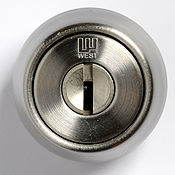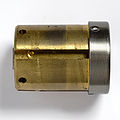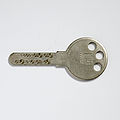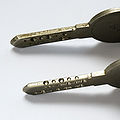WEST 917: Difference between revisions
m (→{{PAGENAME}}: fix markup typo) |
m (→{{PAGENAME}}: include note & link to 916) |
||
| Line 20: | Line 20: | ||
The '''917''' is a [[dimple]] lock made by the Japanese company [[WEST]]. It contains 20 pins, arranged in rows of seven on the left and the top of the keyway as well as six on the right. | The '''917''' is a [[dimple]] lock made by the Japanese company [[WEST]]. It contains 20 pins, arranged in rows of seven on the left and the top of the keyway as well as six on the right. | ||
'' '''Please note:''' the 917 is very similar to the smaller, 12-pin [[WEST 916]] model. The two locks share the same pins, fundamental designs, and primary security features.'' | |||
== Principles of operation == | == Principles of operation == | ||
Revision as of 02:41, 1 December 2022
WEST 917
| WEST 917 | |
 | |
| Name | WEST 917 |
|---|---|
| Manufacturer | WEST |
| Lock Type | Cylinder |
| Lock Design | Pin-tumbler, Dimple |
| Specifications | |
| # of Components | 20 |
| Component Type | Pin-tumbler |
| Related Locks | |
| WEST 916 | |
The 917 is a dimple lock made by the Japanese company WEST. It contains 20 pins, arranged in rows of seven on the left and the top of the keyway as well as six on the right.
Please note: the 917 is very similar to the smaller, 12-pin WEST 916 model. The two locks share the same pins, fundamental designs, and primary security features.
Principles of operation
The WEST 917 utilizes dimple keys but functions the same as a standard pin-tumbler lock. The lock uses 20 chambers for pin-tumbler stacks. Each of those chambers contains a set of key pin, driver, and spring. The key is bitted on the sides and edges of the blade and is reversible. To open the lock, all 20 pin-tumblers -- across all three rows of pins -- must be aligned at the shear line. (See also Pin-tumbler, Principles of Operation)
WEST utilizes a variety of security pins to deter picking. Pin stacks incorporate stainless steel key pins with two sizes of brass driver pins to match. The 917 uses a mix of mushroom spool drivers and standard ones. Drivers are cupped to allow the spring to nest inside the pins. Key pins are a combination of t-pins and multi-section tapered spools which are torpedo shaped to create overset traps. These pin designs match over- and counter-milling of the pin chambers in the core to catch pins as they are lifted to shear.
Gallery
See also
| This article is a stub. You can help Lockwiki by expanding it. |




